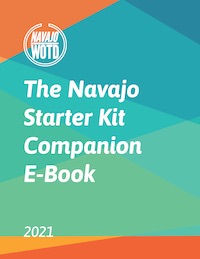Part of the new Navajo Pronunciation Collection are a few lines to introduce yourself in front of groups. In Navajo, it wasn’t very common for people to include their name when they met new groups of people. Much more relevant then, as is now, are the clans and the homesite.
Starting the introduction off is a greeting:
Yá’át’ééh (It is good; welcome; hello)
shik’éí dóó shidine’é (my family and my people, friends)
Following that is usually the name of the person (we’ll use Fenton as an example here):
Shí éí Fenton yinishyé (I am called Fenton)
The name you say should always be your real name; any nicknames or titles shouldn’t be included. Following this are the clans.
In Navajo culture, every person has four clans in the following order: the mother’s first clan, the father’s first clan, the maternal grandfather’s first clan, and the paternal grandfather’s first clan. In English, many people will shorten this part to just “I am (mother’s clan) born for (father’s first clan).”
The pronunciation clip demonstrates how this is said in Navajo (the italicized words are clans):
Tódích’íí’nii nishłį́
Hashk’aan Hadzohí bashishchiin
Tł’ááshchí’í dashicheii
Hooghanłání dashinalí
And then following all of this is the phrase:
Ákót’éego diné nishłį́ (In this way, I am a Navajo male)
The feminine version is:
Ákót’éego diné asdzáán nishłį́ (In this way, I am a Navajo woman)
If one has a heritage that is not part of the clan system, that clan can be substituted with the word a different heritage. For example, Naakai Łizhinii refers to those of African descent - literally it means ‘the black/dark ones that walk about” - or Bilagáana (white people), Naakai dine’é (Mexican people), Kiis’áanii or Oozéí (Hopi), or any other heritage.
The way this clan system is structured results in the mother’s clan being carried forward always, whereas the father’s clan cycles out after two generations.
Towards the end are the places one is from. This is commonly expressed in two ways: where one currently lives, and where one is originally from. The pronunciation presents it in this way (place names are italicized; -di means “at”):
Beesh Sinildi kééhasht’į́ (I reside at Winslow, where the metal lays)
Tsin Názbąs déé’ naashá (From Round Cedar I walk around)
(These two statements are joined by ndi, which equates to “but…”)
And then to close off the introduction is:
Ahéhee’ (Thank You! I am grateful!)
This is the basic introduction in Navajo.
